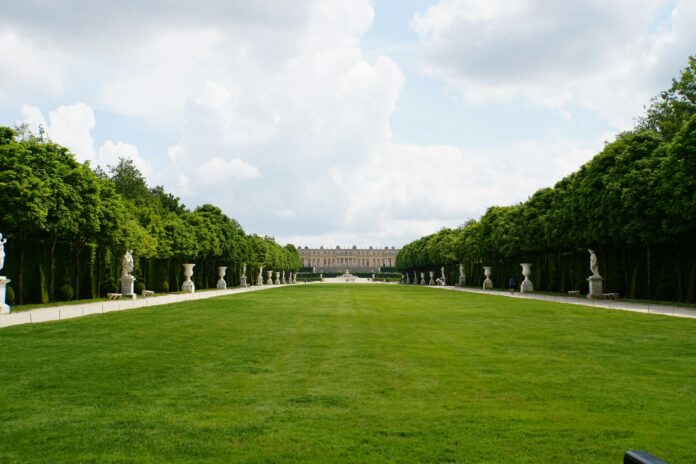
Even before there were lawns, there were gardens.
The garden of Eden – enjoyed, however briefly, by Adam and Eve – was not necessarily the very first garden. News flash for holy Joes who insist on interpreting the Bible literally – this origin story, like many suspiciously similar ones in other world religions, is most probably allegorical.
Many ancient religions feature mystical gardens in their writings. The gardens seem to fulfil both spiritual and physical yearnings. Was Plan A not something about creating paradise here on earth? (I know there was a flooding issue at one stage . . . see Féidhlim Harty’s article in this issue of HC for flood prevention solutions.)
Are all gardeners not subconsciously trying to recreate our own Edens, albeit on far smaller scales, in suburbia? From Babylon’s hanging gardens to Islam’s oases, from mythical Grecian Elysian Fields and medieval monastery cloisters to contemporary flower shows like Chelsea, gardens continue to evolve and intrigue, according to the needs and desires of each age of humanity.
Gardens represent, ever since that unfortunate incident with the snake, man’s dominion over nature. They are microcosms of the natural world. Humanity’s instinct has always been to manipulate the landscape. Tim Ingram, writing on the UK website, ‘Thinkingardens’, says a garden is part of the environment, a synthetic but hopefully functional ecosystem. And Michael Pollan, in his book, Second Nature: A Gardener’s Education, suggests that the garden “might be a place where we can meet nature halfway.”
I like that idea of meeting nature halfway. Could we not also apply it to the ubiquitous lawn? I was amused to find that the word ‘lawn’ comes from the Celtic word, laune (Middle Irish lann, land), which described a communal grass enclosure for grazing livestock. It’s akin to the old French, launde, meaning wooded district or heath – that open space between woods.
A middle class affectation. A cultural juggernaut. And, dare I say it, a male obsession
On the island now known as Britain, such expanses were eventually owned by the medieval aristocracy, who rented them out to their tenants to graze. Not the tenants to graze per se, more for their livestock.
THE MAIN STAGE
According to author Dr DG Hessayon in The Lawn Expert, it was inside aristocrats’ moats, baileys and castles that the English lawn truly began. There was usually an area of grass on which knights and their ladies could walk and sit, well away from the smells and vermin of indoor living.
Whilst gardening may be largely a solo pursuit, gardens have always been social spaces, with lawns, when they developed, becoming the main stage. There were turf-topped seats and even rectangular ‘greens’ on which games such as bowls and pall-mall were played.
Later this lawn area was extended, to cover large open spaces for wealthy landowners around their castles or manor houses. This was to deprive potential attackers of the cover of forests. Thus the original purpose of the sweeping lawn was to be a safeguard against surprise attack.
Famously, one day in 1588, Sir Francis Drake (scoundrel that he was), delayed his attack on the Spanish Armada in order to complete his bowling game on a chamomile lawn. Because of terrible weather and Drake’s clever tactics, the invading fleet fled, and Elizabethan and later Tudor palaces continued to be adorned with grassy mounds, designed to display their owners’ wealth.
In the 1600s, the Jacobeans were big fans of the lawn. The eminent Francis Bacon exclaimed, “Nothing is more pleasant to the eye than green grass finely shorn.” But it was the aristocracy of 17th and 18th century Europe who really got the whole cult of the lawn thing going.
French ‘Sun King’ Louis XIV included large squares of tapia vert, or green carpet, in his magnificent Versailles gardens. This haute couture of landscaping quickly spread. An early form of conspicuous consumerism, it was a way of showing that landowners could afford to dedicate their grounds to aesthetic rather than primarily agricultural purposes.
ALL NATURE IS A GARDEN
Italian landscape artists’ later glorification of idyllic pastoral scenes fed into the next romantic lawn mania. As a backlash to the splendid formality of continental gardens, English landscape designers like Capability Brown exclaimed, “All nature is a garden.” Entire country estates were converted to vast expanses of grass, copses, lakes and the odd folly. Armies of labourers were employed to do some serious earth moving. If something undesirable – say, a local village – was spoiling the view, well then, moved it would be.
ENSLAVED
Meanwhile, in the colonies, the concept of the grass lawn was being enthusiastically imported by the wealthy. In 1776, during the American revolution, General George Washington found time to write to his estate manager at home about his garden design plans. No doubt he was conscious of the symbolism of eschewing the agricultural value of his land in favour of sprawling lawns and gardens.
At this time, most American homesteads merely had packed dirt or wildflower-strewn untamed areas outside (think Little House on the Prairie). Mind you, I’d say the Olsons, especially Nelly, would have loved a nice lawn, regardless of the endless upkeep and expense for her long-suffering Pa.
Another notable early American adopter was Thomas Jefferson at his Monticello plantation. Third US president, author of the Declaration of Independence, and big fan of the rights of man, Jefferson’s expanses of shorn grass served no other purpose but to send a message about the ambitions of this newly founded and proud nation.
It’s fair comment to record that Jefferson hypocritically deployed lots of slaves to keep the lawn in tip-top condition. Lacking modern equipment, this was gruelling, endless work.
OLMSTED’S VISION
After the American Civil War ended, new suburbs sprang up everywhere. These often had large grassy areas inspired by the ubiquitous urban city parks. The spread of railway lines to and through these same suburbs had the unexpected side effect of providing a raised and moving platform for commuters, who could now sit gazing out the windows (Long Island iced teas had yet to be invented), no doubt comparing the now visible yards of their neighbours with their own.
Later again in the 1800s one Frederick Law Olmsted, founding father of American landscape architecture, admired the uninterrupted green swards of grand English estates. Fred envisioned carpets of lawn throughout the new suburban developments that were springing up everywhere.
“The lawn,” declared Olmsted, “would be an expression of democracy.” And so it came to pass.
Drive down any American suburban street, no matter what city, and one can readily observe Olmsted’s vision, one front lawn flowing into the next all the way down the block. This is the case regardless, or even in defiance, of the geography, location or prevailing climate. What started out as a status symbol became an even more entrenched aesthetic.
The culture really shifted following the 1870 publication of the highly influential bestseller, The Art of Beautifying Suburban Home Grounds of Small Extent, by Frank Jesup Scott. The book declared that having a perfect lawn was part of what makes a perfect citizen.
Just one year later, one Mr Joseph Lessler filed a new patent for his easily connected garden hose sprinkler system. Thanks to Joe’s sprinklers, most US lawns don’t even use native grass. Like the Victorians back in Blighty, where lawns were already being taken for granted, middle class America was hooked.
LAWN + BORDERS = CLASSIC CONVENTION
The cool damp climate of the northern European archipelago happens to suit the growing of grass very well. Ireland, aka the Emerald Isle, even got its nickname from it. On this side of the Atlantic, it’s the back garden where the lush lawn reigns supreme. Castles and villas gave way to smaller, more modest homes and city gardens.
During the ‘age of empire and exploration’, the culture began of gardens being filled with exotic plants brought back from around the globe. It turned out that lawns set off the snazzy beds very nicely, thank you. They covered the ground superbly and were installed relatively cheaply. Much like the Dude’s rug in The Big Lebowski, the lawn really, like, tied the space together, man. Great for play and relaxation, the tidy openness of the lawn became comfortably familiar. A patch of grass into which many poured their heart and soul. After all, an Englishman’s home is his castle.
‘LAWNAGEDDON’: REVOLUTION AND EVOLUTION
As for the issue of lawn maintenance, well, the Industrial Revolution took care of that. In 1832 an enterprising chap named Edwin Budding, observing the cutting machines in the busy textile factories, was inspired to invent the manual cylinder mower, thus facilitating keeping lawns neatly shorn. The first manual mowers were pulled by ponies in soft leather boots to protect the grass.
The Americans soon came up with an even more efficient ‘archimedean’ mower, and a steam-driven mower appeared in 1893. Petrol models followed in the early 1900s, and the famous flymo appeared in the late 1960s.
Along with apple pie and that white picket fence, the neatly cut lawn was now finally an entrenched part of the American dream. Yet despite all the technological progress, according to historian Ted Steinberg in American Green: The Obsessive Quest for the Perfect Lawn, citizens still spent 150 hours a year maintaining their lawns.
SUBURBAN ORDER OVER CITY SQUALOR
In her seminal 2015 article, ‘The Life and Death of the American Lawn’, Megan Graber wrote: “Lawns became aesthetic extensions of manifest destiny, symbols of American entitlement and triumph, of the soft and verdant rewards that result when man’s ongoing battles against nature are finally won. They represented the order of suburbia over the squalor of the [inner] city.”
What had started as defence and status, morphed into vanity, and then evolved into cultural convention. A 1914 New York Times headline literally read ‘Roosevelt cuts his lawn’. Today the lawn is so pervasive in society that we expect homeowners to have and to maintain a lawn. It’s even enforced by law in many instances, for example in the US through Homeowner Associations. Lawns became a non-negotiable part of the package of home ownership.
MOWING MANIA
During World War Two, citizens were encouraged to continue lawn maintenance ‘as a show of strength and unity’. After the war, returning veterans were given cheap loans to buy even more new suburban houses. These would not, of course, be complete without a yard.
The new interstate highway system in the US also helped to spread lawns. One side effect of this infrastructural investment was a further explosion of suburbia, along with its inevitable gardens, which apparently take up over 20 per cent of urban areas in the US. The American Green book called these rows of tidy lawns an expression of 1950s conformity. (Listen to Pete Seeger’s 1963 hit, ‘Little Boxes’.)
Social pressures are the root of the lawn conformity problem. Local ordinances in some US states still dictate the required height of lawn grass. The phrase ‘keeping up with the Joneses’ is particularly apt in this context. (It comes from a syndicated US comic strip which ran from 1913 to 1940; long enough to enter the popular lexicon.) A hundred years ago, the Chicago Tribune declared, “A well-manicured patch of grass is synonymous with status and good citizenship.”
Here’s today’s news:
The lawn is in fact a high maintenance, wasteful and labour intensive affectation. It’s a high energy and chemically dependent monoculture whose genesis lies in the expression of power and wealth over nature. It is a multimillion dollar and multimillion acre fetish.
A pandemic of utterly redundant pastures.
A middle-class affectation. A cultural juggernaut.
And, dare I say it, a male obsession.
Oh, lawns and lawn care are big business alright, the pursuit of this weedless swathe being the holy grail of suburbia. Let’s face it, we’ve all been brainwashed into accepting a sacred cow – the lawn. We prostrate ourselves over its care, we genuflect in pursuit and in servility to its perfection. It was US writer Pat Howell who said, “Grass is the cheapest plant to install and the most expensive to maintain.”
We are unwittingly enslaved by our lawns. What a sad state of affairs. I don’t wish to be thought sacrilegious, but I think these neatly trimmed symbols of civic virtue of dubious morality have completely outlived their usefulness. Are you starting to see where I’m going with all this? Few suspect that the sacrosanct icon that lawns have become is a really bad idea.
The pressure to protect and maintain this manicured monstrosity, this al fresco green rug has led to an unhealthy, unthinking national obsession with its appearance. Countless hours are spent – I would say squandered – raking, spiking, scarifying, fertilising and feeding this monster. More fertiliser = more growth = even more mowing. And people have the temerity to tell me my synthetic solution – not the only alternative – is the abomination. Please.
Do we need to remain trapped on this treadmill? Let me leave you with the title of a Washington Post article by Christopher Ingraham, which neatly summarises my own conclusion:
‘Lawns Are a Soul-Crushing Time Suck and Most of Us Would Be Better Off Without Them.’
 Mark O’Loughlin is a 54-year-old mostly office-bound landscaper with grey hair who loves transforming spaces using artificial grass. He is the owner and director of Sanctuary Synthetics. Winner of five Bloom medals, Mark previously risked ridicule with his HidBin invention on Dragon’s Den. He is the author of The Big Hairy Green Book: All About Artificial Grass (available on Amazon).
Mark O’Loughlin is a 54-year-old mostly office-bound landscaper with grey hair who loves transforming spaces using artificial grass. He is the owner and director of Sanctuary Synthetics. Winner of five Bloom medals, Mark previously risked ridicule with his HidBin invention on Dragon’s Den. He is the author of The Big Hairy Green Book: All About Artificial Grass (available on Amazon).






